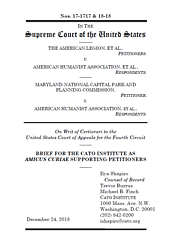Learn more about Cato’s Amicus Briefs Program.
When most people see a World War I memorial cross, they probably remember the American soldiers who heroically sacrificed their lives in Europe during that great conflagration. Some may take it as a recognition of the soldiers’ shared faith and the hope that they may live on—no doubt a comfort to the generations of family they left behind. The Peace Cross has stood in Maryland for almost a century as a monument to fallen soldiers who served in the Great War. Because it is a cross, however, and it sits on government land, it has become the target of offended humanists who view it as insulting to non-religious soldiers. They insist, disregarding all constitutional context, that it is a violation of the Establishment Clause. Cato has filed a brief supporting the defenders of the cross, arguing that a cross on public land is not an “establishment of religion” under the original public meaning of the First Amendment.
James Madison, arguably the most influential framer of the Constitution, strongly opposed state religion because colonial Virginia was teeming with religious persecution. Preachers were jailed for simply publishing their religious views, and the official state religion was integrated with many parts of the government. This had a profound effect on Madison. When he wrote his draft of the First Amendment, Madison envisioned the Establishment Clause as the culmination of his philosophy on religion and government, with liberty of conscience as the centerpiece. His purpose was to ensure that people could exercise their faith free from compulsion. The Establishment Clause, thus, was a shield to defend “individual liberty of conscience.” He did not, however, fashion the Establishment Clause as a sword, to be used against innocuous religious symbols on government land.
In the Fourth Circuit’s ruling here, the court applied a multi-factor test that the Supreme Court introduced in the 1971 case of Lemon v. Kurtzman. The “Lemon test” is notoriously vague and difficult to apply, and in recent history the Court has largely avoided using test because it muddles the Establishment Clause by adding a multitude of confusing, unworkable factors such as “secular purpose,” “primary effect,” “advances,” “inhibits,” “foster,” and “excessive entanglement.” As Justice Scalia humorously—and correctly— noted in one dissent, the Lemon test is like an undead ghoul that haunts the Court’s jurisprudence and just won’t seem to go away.
The Court should do away with the ghoulish Lemon test and return to the original meaning of the Establishment Clause. While Lemon has been around for almost 50 years, it does not deserve the protection of the doctrine of stare decisis, a Latin term that protects precedent in order to “to stand by things decided.” Stare decisis plays a crucial role in American constitutional law, but it should not protect decisions that are divorced from the original meaning of the Constitution, have proven unworkable, and have been abandoned by many justices on the Court.
Instead of relying on nebulous factors, it should rely on the original public meaning of the religious provisions of the First Amendment: to ensure liberty of conscience and to protect people from truly “established” state religions that coerce belief and support. A non-coercive, harmless monument—a cross memorial, or a Star of David, or any other religious symbol—is not an establishment of religion. Tearing down the memorial instead establishes an anti-religious orthodoxy, with a mandate that religious symbols be eradicated from public life to create a sanitized government. The Framers did not intend for that to happen, and the Court should ensure that the First Amendment gets the last word.

This work is licensed under a Creative Commons Attribution-NonCommercial-ShareAlike 4.0 International License.




